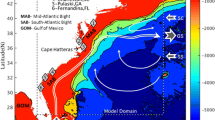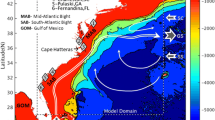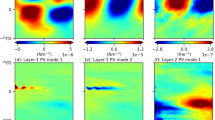Abstract
The oceanic mixed layer (OML) response to an idealized hurricane with different propagation speeds is investigated using a two-layer reduced gravity ocean model. First, the model performances are examined with respect to available observations relative to Hurricane Frances (2004). Then, 11 idealized simulations are performed with a Holland (Mon Weather Rev 108(8):1212–1218, 1980) symmetric wind profile as surface forcing with storm propagation speeds ranging from 2 to 12 m s−1. By varying this parameter, the phasing between atmospheric and oceanic scales is modified. Consequently, it leads to different momentum exchanges between the hurricane and the OML and to various oceanic responses. The present study determines how OML momentum and heat budgets depend on this parameter. The kinetic energy flux due to surface wind stress is found to strongly depend on the propagation speed and on the cross-track distance from the hurricane center. A resonant regime between surface winds and near-inertial currents is clearly identified. This regime maximizes locally the energy flux into the OML. For fast-moving hurricanes (>6 m s−1), the ratio of kinetic energy converted into turbulence depends only on the wind stress energy input. For slow-moving hurricanes (<6 m s−1), the upwelling induced by current divergence enhances this conversion by shallowing the OML depth. Regarding the thermodynamic response, two regimes are identified with respect to the propagation speed. For slow-moving hurricanes, the upwelling combined with a sharp temperature gradient at the OML base formed in the leading part of the storm maximizes the oceanic heat loss. For fast propagation speeds, the resonance mechanism sets up the cold wake on the right side of the hurricane track. These results suggest that the propagation speed is a parameter as important as the surface wind speed to accurately describe the oceanic response to a moving hurricane.















Similar content being viewed by others
References
Bender A, Ginis I, Kurihara Y (1993) Numerical simulations of tropical cyclone–ocean interaction with a high-resolution coupled model. J Geophys Res 98(D12):23245–23263. doi:10.1029/93JD02370
Black P, D'Asaro E, Drennan E, French J, Niiler J, Sanford T, Terrill E, Walsh E, Zhang J (2006) Air–sea exchange in hurricanes: synthesis of observations from the coupled boundary layer air–sea transfer experiment. Bull Am Meteorol Soc 88:357–374. doi:10.1175/BAMS-88-3-357
Chang S, Anthes R (1978) Numerical simulations of the ocean's nonlinear, baroclinic response to translating hurricanes. J Phys Oceanogr 8:468–480. doi:10.1175/1520-0485(1978)008<0468:NSOTON>2.0.CO;2
Chen S, Price J, Zhao W, Donelan M, Walsh E (2007) The CBLAST-hurricane program and the next-generation fully coupled atmosphere–wave–ocean models for hurricane research and prediction. Bull Am Meteorol Soc 88:311–317. doi:10.1175/BAMS-88-3-311
D'Asaro E, Sanford T, Niiler P, Terrill E (2007) Cold wake of Hurricane Frances. Geophys Res Lett 34:15. doi:10.1029/2007GL030160
Donelan M, Haus B, Reul N, Plant W, Stiassnie M, Graber H, Brown O, Saltzman E (2004) On the limiting aerodynamic roughness of the ocean in very strong winds. Geophys Res Lett 31:18. doi:10.1029/2004GL019460
Donlon C, Robinson I, Casey KS, Vazquez-Cuervo J, Armstrong E, Arino O, Gentemann C, May D, LeBorgne P, Piollé J, Barton I, Beggs H, Poulter DJS, Merchant CJ, Bingham A, Heinz S, Harris A, Wick G, Emery B, Minnett P, Evans R, Llewellyn-Jones D, Mutlow C, Reynolds RW, Kawamura H, Rayner N (2007) The global ocean data assimilation experiment high-resolution sea surface temperature pilot project. Bull Am Meteorol Soc 88:1197–1213. doi:10.1175/BAMS-88-8-1197
Drennan W, Zhang J, French J, McCormick C, Black P (2007) Turbulent fluxes in the hurricane boundary layer. Part II: latent heat flux. J Atmos Sci 64(4):1103–1115. doi:10.1175/JAS3889.1
Emanuel K (1986) An air–sea interaction theory for tropical cyclones. Part I. Steady-state maintenance. J Atmos Sci 43(6):585–605. doi:10.1175/1520-0469(1986)043<0585:AASITF>2.0.CO;2
Emanuel K (1995) Sensitivity of tropical cyclones to surface exchange coefficients and a revised steady-state model incorporating eye dynamics. J Atmos Sci 52(22):3969–3976. doi:10.1175/1520-0469(1995)052<3969:SOTCTS>2.0.CO;2
Emanuel K (2003) A similarity hypothesis for air–sea exchange at extreme wind speeds. J Atmos Sci 60(11):1420–1428
French J, Drennan W, Zhang J, Black P (2007) Turbulent fluxes in the hurricane boundary layer. Part I: momentum flux. J Atmos Sci 64(4):1089–1102. doi:10.1175/JAS3887.1
Garwood R Jr (1977) An oceanic mixed layer model capable of simulating cyclic states. J Phys Oceanogr 7(3):455–468. doi:10.1175/1520-0485(1977)007<0455:AOMLMC>2.0.CO;2
Gaspar P (1988) Modeling the seasonal cycle of the upper ocean. J Phys Oceanogr 18(2):161–180. doi:10.1175/1520-0485(1988)018<0161:MTSCOT>2.0.CO;2
Geisler J (1970) Linear theory of the response of a two layer ocean to a moving hurricane. Geophys Astrophys Fluid Dyn 1:249–272
Gill AE (1984) On the behavior of internal waves in the wakes of storms. J Phys Oceanogr 14(7):1129–1151. doi:10.1175/1520-0485(1984)014<1129:OTBOIW>2.0.CO;2
Greatbatch R (1983) On the response of the ocean to a moving storm: the nonlinear dynamics. J Phys Oceanogr 13(3):357–367. doi:10.1175/1520-0485(1983)013<0357:OTROTO>2.0.CO;2
Greatbatch R (1984) On the response of the ocean to a moving storm parameters and scales. J Phys Oceanogr 14(1):59–78. doi:10.1175/1520-0485(1984)014<0059:OTROTO>2.0.CO;2
Holland G (1980) Analytic model wind press profiles hurricanes. Mon Weather Rev 108(8):1212–1218
Jacob S, Shay L (2003) The role of oceanic mesoscale features on the tropical cyclone-induced mixed layer response. A case study. J Phys Oceanogr 33(4):649–676. doi:10.1175/1520-0485(2003)33<649:TROOMF>2.0.CO;2
Kolmogorov AN (1942) The equation of turbulent motion in an incompressible fluid. Izv Akad Nauk SSSR Ser Fiz 6:56–58
Kraus EB, Turner JS (1967) A one-dimensional model of the seasonal thermocline. II. The general theory and its consequences. Tellus 19:98–106
Levitus S, Boyer TP (1994) World Ocean Atlas 1994, vol 4. Temperature. NOAA Atlas NESDIS 4. US Government Printing Office, Washington, DC, 117 pp
Levitus S, Burgett R, Boyer TP (1994) World Ocean Atlas 1994, vol 3. Salinity. NOAA Atlas NESDIS 3. US Government Printing Office, Washington, DC, 99 pp
Makin V (2005) A note on the drag of the sea surface at hurricane winds bound-layer. Meteorology 115(1):169–176
Niiler P, Kraus E (1977) One dimension models of the upper ocean. In: Kraus EB (ed) Modeling and prediction of upper layers of the ocean. Pergamon, New York, pp 143–172
O’Brien JJ (1967) The non-linear response of a two-layer, baroclinic ocean to a stationary, axially-symmetric hurricane. Part II. Upwelling induced by momentum transfer. J Atmos Sci 24(2):208–214
Powell M, Houston S, Amat L, Morisseau-Leroy N (1998) The HRD real-time hurricane wind analysis system. J Wind Eng Ind Aerodyn 77:53–64
Powell M, Vickery P, Reinhold T (2003) Reduced drag coefficient for high wind speeds in tropical cyclones. Nature 422:279–283. doi:10.1038/nature01481
Price J (1981) Upper ocean response to a hurricane. J Phys Oceanogr 11(2):153–175. doi:10.1175/1520-0485(1981)011<0153:UORTAH>2.0.CO;2
Price J (1983) Internal wave wake of a moving storm. Part I: scales, energy budget and observations. J Phys Oceanogr 13(6):949–965. doi:10.1175/1520-0485(1981)011<0153:UORTAH>2.0.CO;2
Price J, Sanford T, Forristall G (1994) Forced stage response to a moving hurricane. J Phys Oceanogr 24(2):233–260. doi:10.1175/1520-0485(1994)024<0233:FSRTAM>2.0.CO;2
Sanford T, Black P, Haustein J, Feeney J, Forristall G, Price J (1987) Ocean response to a hurricane. Part I: observations. J Phys Oceanogr 17(11):2065–2083. doi:10.1175/1520-0485(1987)017<2065:ORTAHP>2.0.CO;2
Sanford T, Price J, Girton J, Webb D (2007) Highly resolved observations and simulations of the ocean response to a hurricane. Geophys Res Lett 34(13):L13604. doi:10.1029/2007GL029679
Schade L (2000) Tropical cyclone intensity and sea surface temperature. J Atmos Sci 57(18):3122–3130
Shay L, Elsberry R, Black P (1989) Vertical structure of the ocean current response to a hurricane. J Phys Oceanogr 19(5):649–669. doi:10.1175/1520-0485(1989)019<0649:VSOTOC>2.0.CO;2
Shay L, Black P, Mariano A, Hawkins J, Elsberry R (1992) Upper ocean response to Hurricane Gilbert. J Geophys Res 97(C12):20227–20248. doi:10.1029/92JC01586
Weill A, Eymard L, Caniaux G, Hauser D, Planton S, Dupuis H, Brut A, Guerin C, Nacass P, Butet A et al (2003) Toward a better determination of turbulent air–sea fluxes from several experiments. J Clim 16(4):600–618
Acknowledgments
This work was supported by the Université Paul Sabatier Toulouse III, Météo-France and the Centre National de la Recherche Scientifique. We would like to thank Tom Sanford and John Dunlap for providing the autonomous profiling float (EM-APEX) data and Françoise Orain for providing the SST analysis fields.
Author information
Authors and Affiliations
Corresponding author
Additional information
Responsible Editor: Richard John Greatbatch
Appendix
Appendix
1.1 Impact of the wind field asymmetry on the OML response
An additional simulation has been conducted to quantify the effect of an asymmetric component in the surface wind field on the oceanic response. This asymmetry depends directly on the hurricane propagation speed. As a consequence, we investigate the case of the fastest moving storm (U H = 12 m s−1) to check the range of validity of our results.
The surface wind field is multiplied by (1 + c cos θ), where θ is the horizontal azimuth (increasing counterclockwise from east) and c = U H/2V(r), where V(r) is the surface wind speed at a radial distance r from the storm center. For U H = 12 m s−1 and V max = 50 m s−1, we obtain c = 0.12 which is comparable with the asymmetry factors used in previous studies (Chang and Anthes 1978; Price 1981; Greatbatch 1983). For distances greater than RMW, c increases because of the decrease of V(r), and the asymmetric component becomes more important on each side of the storm track. In Fig. 16, this new asymmetric wind field is compared to the symmetric one.
When applying the asymmetric factor, the wind speed reaches 56 m s−1 on the right side of the hurricane and decreases to 44 m s−1 on the left side of the hurricane. The extensions of the 20 and 10-m s−1 isotachs are multiplied by a factor 2 on the right-hand side of the hurricane.
The impact of this asymmetric wind field on the SST pattern is presented in Fig. 17 in terms of SST difference between the asymmetric and the symmetric case. On the right-hand side of the storm, the wind asymmetry intensifies the maximum cooling by 0.4°C between 200 and 350 km (i.e., 3.3 and 5.8 RMW). This means that the perturbation induced by the asymmetric wind field is mostly located outside the studied region. Between 0 and +3 RMW, the temperature difference is equal or less than 0.3°C, which is small compared to the cooling induced by the symmetric wind field (2.2°C). As a consequence, the maximum cooling location remains at the same place in both cases. This difference is twice as small as the cooling difference observed between the simulations with U H = 10 and 12 m s−1. On the left side of the storm, the cooling decreases by 0.2°C between 100 and 200 km (1.6 and 3.3 RMW). This difference is small compared to the 1.6°C cooling observed in this region with the symmetric wind field. The central region temperature (between −2 and +2 RMW) difference induced by the asymmetric wind field is equal or less than 0.1°C. Finally, the SST response extends slightly more on the right side of the storm than in the symmetric case, but the cooling differences are small compared to that induced by varying the propagation speed.
The impact of the asymmetric wind field on the MKE pattern is presented in Fig. 18 in terms of MKE difference between the asymmetric and the symmetric case. The maximum MKE difference, which is less than 0.15 m2 s−2, is located between 150 and 300 km (i.e., 3.3 and 5.8 RMW) on the right-hand side of the storm. This difference is small compared to the maximum MKE produced by the symmetric wind field between 50 and 100 km (i.e., 0.8 and 1.7 RMW) which is about 0.65 m2 s−2. The left-hand side of the hurricane is not affected in terms of MKE by the asymmetric wind field because of the very small amount of MKE in this region. The MKE distribution in the central region (−100 km < x < 100 km) is also not modified by the asymmetric wind field (<0.05 m2 s−2). Globally, we observe a slightly more biased MKE distribution toward the right of track, but it does not modify the characteristics of the MKE pattern observed in the symmetric case.
These results are in good agreement with the previous findings of Chang and Anthes (1978), Price (1981), and Greatbatch (1983) who showed that the wind asymmetric component has a small impact on the OML response. Moreover, we found that the impact of the asymmetric wind field decreases when the storm translation speed decreases. Furthermore, when decreasing U H, the cooling induced by the resonance mechanism and nonlinear dynamics strongly increases, while the cooling induced by the wind field asymmetry decreases. Hence, we can conclude that the asymmetric wind field has a limited impact on the OML response and can be ignored without compromising the validity of our results.
Rights and permissions
About this article
Cite this article
Samson, G., Giordani, H., Caniaux, G. et al. Numerical investigation of an oceanic resonant regime induced by hurricane winds. Ocean Dynamics 59, 565–586 (2009). https://doi.org/10.1007/s10236-009-0203-8
Received:
Accepted:
Published:
Issue Date:
DOI: https://doi.org/10.1007/s10236-009-0203-8







